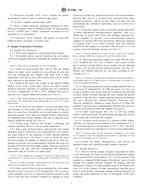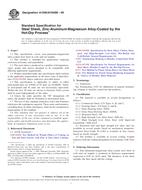1.1 This classification system covers polybutylene plastics materials suitable for molding and extrusion.
1.2 This classification system is applicable to all butene homopolymers and to copolymers of butene with a maximum content of other 1-olefinic monomers of less than 50 % and with a content of non-olefinic monomers with functional groups up to a maximum of 1 %.
1.3 This classification system allows for the use of those polybutylene plastic materials that are to be recycled, reconstituted, and reground, provided the following conditions are met:
1.3.1 The requirements as stated in this classification system and other guideline pertaining to these materials are met, and
1.3.2 The material has not been modified in any way to alter its conformance to water contact regulations or other similar requirements.
1.4 The proportions of recycled, reconstituted, and regrind material used, as well as the nature and the amount of any contaminant, cannot be practically covered in this classification system. It is the responsibility of the supplier and buyer of recycled, reconstituted, and regrind materials to ensure compliance.
1.5 The properties included in this classification system are those required to characterize and classify the specific product. Other properties are necessary to identify particular characteristics important to specialized applications. These are specified by using suffixes as given in Section 5. Properties shall be selected in such a manner that consistency of different lots or shipments is assured. The tests involved in this classification system are intended to provide information for identifying materials in accordance with types and categories. It is not the function of this classification system to provide specific engineering data for design purposes.
1.6 This classification system and subsequent line callout (specification) are intended to provide a means of calling out plastic materials used in the fabrication of end items or parts. It is not intended for the selection of materials. Material selection is to be made by those having expertise in the plastic field after careful consideration of the design and the performance required of the part, the environment to which it will be exposed, the fabrication process to be employed, the costs involved, and the inherent properties of the material other than those covered by this standard.
1.7 The values stated in SI units are to be regarded as the standard. The values given in parentheses are for information only.
Note 1 – This standard, ISO 8986-1, and ISO 8986-2 address the same subject matter, but differ in technical content.
1.8 The following precautionary caveat pertains only to the test methods portion, Section 11, of this classification system: This standard does not purport to address all of the safety concerns, if any, associated with its use. It is the responsibility of the user of this standard to establish appropriate safety and health practices and determine the applicability of regulatory limitations prior to use.
Product Details
- Published:
- 08/01/2009
- Number of Pages:
- 10
- File Size:
- 1 file , 160 KB
- Redline File Size:
- 2 files , 280 KB


